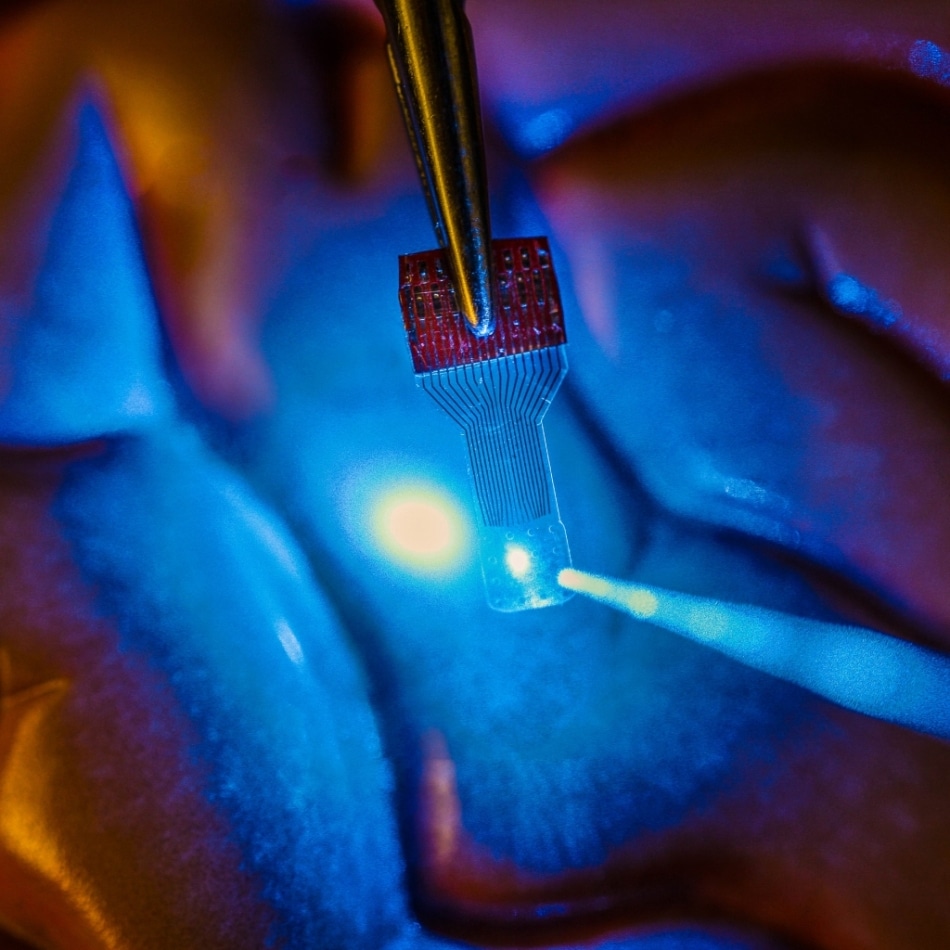Oct 14 2016
 A blue light shines through a clear, implantable medical sensor onto a brain model. See-through sensors, which have been developed by a team of UW–Madison engineers, should help neural researchers better view brain activity. (Credit: Justin Williams Research Group)
A blue light shines through a clear, implantable medical sensor onto a brain model. See-through sensors, which have been developed by a team of UW–Madison engineers, should help neural researchers better view brain activity. (Credit: Justin Williams Research Group)
Engineers from the University of Wisconsin–Madison built transparent sensors for use in imaging the brain two years ago. This significant breakthrough was noted by researchers around the world, and many requests flooded the team.
The details of their research were published in the Nature Communications journal.
So many research groups started asking us for these devices that we couldn’t keep up.
Zhenqiang Ma, Professor, UW-Madison
Zhenqiang (Jack) Ma is the Lynn H. Matthias Professor and Vilas Distinguished Achievement Professor in electrical and computer engineering at UW–Madison. Ma’s group are world leaders in developing innovative flexible electronic gadgets. The transparent, implantable micro-electrode arrays were the most highly advanced products created.
Even though he and collaborator Justin Williams, the Vilas Distinguished Achievement Professor in biomedical engineering and neurological surgery at UW–Madison, patented the technology through the Wisconsin Alumni Research Foundation, they envisioned its potential for advancements in research.
That little step has already resulted in an explosion of research in this field. We didn’t want to keep this technology in our lab. We wanted to share it and expand the boundaries of its applications.
Justin Williams, Professor, UW-Madison
Consequently, the researchers have explained in great detail the method to fabricate and use transparent graphene neural electrode arrays in applications in fluorescent microscopy, electrophysiology, optogenetics and optical coherence tomography in a paper published on October 13, 2016 in the Nature Protocols journal.
“We described how to do these things so we can start working on the next generation,” says Ma.
Currently, the UW–Madison research team is working on ways to enhance and upgrade the technology as well as ways to increase its applications from neuroscience into areas such as research of epilepsy, stroke, cardiac conditions, and Parkinson’s disease. They also hope other researchers will do the same.
This paper is a gateway for other groups to explore the huge potential from here. Our technology demonstrates one of the key in vivo applications of graphene. We expect more revolutionary research will follow in this interdisciplinary field.
Zhenqiang Ma, Professor, UW-Madison
Funding for the primary research was provided by the Reliable Neural-Interface Technology program at the U.S. Defense Advanced Research Projects Agency.
Other authors on the Nature Protocols paper include Dong-Wook Park, Sarah Brodnick, Jared Ness, Lisa Krugner-Higby, Solomon Mikael, Joseph Novello, Hyungsoo Kim, Dong-Hyun Baek, Jihye Bong, Kyle Swanson and Wendell Lake of UW–Madison; Farid Atry, Seth Frye and Ramin Pashaie of the University of Wisconsin-Milwaukee; Amelia Sandberg of Medtronic PLC Neuromodulation; Thomas Richner of the University of Washington; and Sanitta Thongpang of Mahidol University in Bangkok, Thailand.